
17 minute read
Chapter 13: The International Space Station
from Unit 7 Astronomy
by tdeleault
Chapter 13
The International Space Station
Advertisement
Would you like to have a bedroom in outer space? Some astronauts do!
The United States and other countries use the space shuttle to send astronauts to an international space station� The space station orbits Earth� Three astronauts can live there at one time� They stay for six months at a time� This image shows the space station�
The space station orbits Earth.
The space station orbits far above Earth� So the astronauts in the space station don’t feel the effects of gravity like we do on Earth� When we lift our arms and legs here on Earth, we have to work against gravity� That is good for us� It helps us stay in shape� But astronauts in space don’t have the effects of gravity to work against� They do not get much of a workout from drifting around� They have to run at least once a day to stay in good shape� In this image, you can see an astronaut jogging in space�
Astronauts have to jog in space to stay in shape.
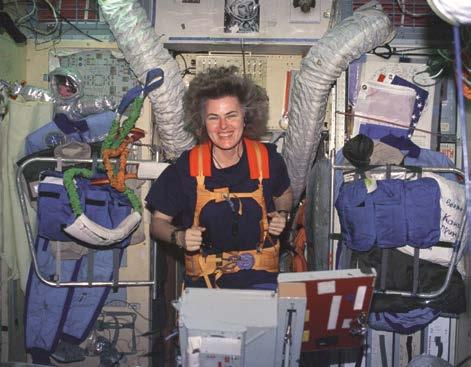
These two astronauts are taking a nap in space.
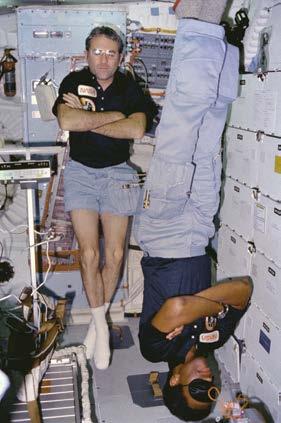
These two men are sleeping in space� They don’t feel the effects of gravity so they are moving freely within the spaceship� This means they can sleep right side up or upside down� It is all the same� Do you think you would like sleeping this way?
Taking a shower in space is tricky� On Earth, the water comes out of the spout� It falls down and splashes on your body� Then, it runs off� But this is not what happens in space! In space, you have to rub the water on your skin� Also, it does not just drip off� You have to scrape it off� You have to shower in a little pod� The pod keeps the water you scrape off your skin from drifting off in the air� If it drifted off, it might cause problems� It might mess up the computers and equipment inside the space station�
You can see that lots of things are different when you live in space� That is why leaving the space station and coming back to Earth can be hard� It takes time for the astronauts to get used to Earth again� After months in space, they struggle with the gravity on Earth� Their arms and legs feel heavy� They find it hard to stand up� They feel off balance� But in a few weeks, they begin to feel normal again� Sometimes when they look up at the sky, they even feel a little homesick for their home in outer space�

An astronaut taking a space shower
Chapter 14
The Big Bang
Have you ever wondered how the universe and our solar system came to be? Astronomers have studied the universe for thousands of years� During that time, people suggested many different explanations of how our solar system began�
With the help of telescopes, modern astronomers noticed that all of the distant galaxies in the universe seem to be moving outward� The more distant the galaxies, the faster they are moving outward� Stars are moving away from Earth and so are whole galaxies� In 1929, a scientist named Edwin Hubble discovered this distance versus speed that is now called “Hubble’s Law�” (This is the same “Hubble” after whom the Hubble Telescope is named!)

Edwin Hubble discovered that all the distant galaxies in the universe seem to be moving outward.
Hubble’s observation led scientists to offer explanations of how the solar system started� There are many explanations, or theories, about how the universe came to be� One recent theory or idea is known as the Big Bang Theory� A theory in science tries to explain how something happened or how something works�
Three astrophysicists proposed the Big Bang Theory in the 1960s� Astrophysicists are scientists who use math to study the universe� George Lemaitre, Alexander Friedmann, and Edwin Hubble studied the theories of another scientist by the name of Albert Einstein� They used his ideas to develop their explanation of how the universe first started�
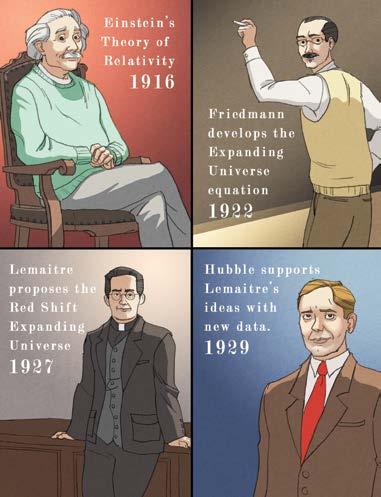
Many astrophysicists contributed to the development of the Big Bang Theory.
They suggested that long ago, the universe and everything in it was once a tiny ball� All of the stuff that makes the universe (called matter) was squeezed together into one tiny space� Imagine if all the planets and all the stars were squeezed together to fit in your hand� That is how tight and tiny the ball was! Scientists think that everything began expanding outward about 14 billion years ago� All the matter in the universe exploded out at once! That is why the event is called the Big Bang�
When all the matter in the ball began moving out, it was very hot� It was hotter than even the hottest star� Everything was moving so fast as it expanded that nothing could stick together� It was too hot and fast for anything to be like what it is today� There were no galaxies, no stars, no planets, and no people�
But over time the matter began to cool� As the matter cooled and stopped moving so fast, gravity was able to hold little bits of matter together in spheres� These little spheres, with the help of gravity, came together and became the first stars and galaxies� Over billions of years of matter moving and growing, the universe became the way it looks today� The sun and planets in our solar system formed about four billion years ago�

All matter in the universe expanded out from one tiny point.
Scientists are continuing to look into space for more clues about the Big Bang� There is still a lot to learn about the early universe� Scientists sometimes make minor changes to the Big Bang Theory to match what they have learned� It is amazing to think how old our solar system is and that scientists are still trying to find out how it all started!

This satellite helped scientists learn more about the early universe.
Chapter 15
Nicolaus Copernicus
Do you remember in the very first chapter of this reader you learned that long ago, people believed that the sun moved around Earth? This seemed to make sense� Each morning at the start of the day, the sun rose in the east� At the end of the day, the sun set in the west—exactly opposite from where it had come up� To explain this change, people said the sun moved around Earth� This is what the Greeks and other ancient people believed� But you also learned in the first chapter that this was not true�
About the same time that Christopher Columbus arrived in America, a man named Nicolaus Copernicus was studying math and astronomy at a university in Poland� He later moved to Italy where he also studied medicine and law�

Young Copernicus studied math, astronomy, medicine, and law.
But Copernicus’ real love was astronomy� He knew that since ancient times, people believed that the sun moved around Earth� Copernicus began to carefully observe and record the movement of the sun, planets, and stars� After much research, Copernicus decided that the belief that the sun moved around Earth could not be true� Copernicus’ observations led him to believe just the opposite! He realized that instead, Earth was moving around the sun! He also believed that as Earth orbited the sun, it also completed a full rotation each day�
All of Copernicus’ ideas came from viewing space without the help of a telescope� He wrote down what he observed from a cathedral bell tower� He also used math to help him prove his point� Finally, Copernicus wrote a book explaining his new ideas about how the universe worked� His fellow scientists went to work trying to prove him wrong, but they couldn’t� Most were amazed by his discovery!
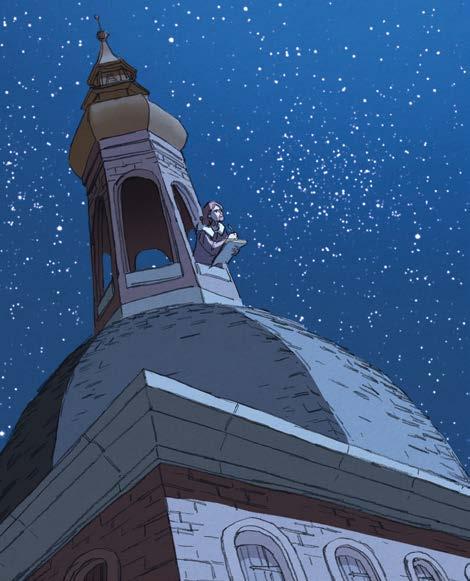
Copernicus spent hours observing the movement of the stars, planets, and sun.
However, Copernicus’ ideas were different from what people had believed for thousands of years� They believed that Earth and humans were the center of the universe� Many of the teachings of the church at that time were also based on this belief� Copernicus had dared to suggest that Earth was not the center of the universe� Instead, he said, the sun was at the center! Many in the church disagreed with Copernicus’ ideas and spoke out against them� So, his beliefs were not widely accepted while he was alive�
In fact, even after Copernicus died, the church continued to argue against the view that the sun was at the center of the universe� Some scientists agreed with Copernicus’ ideas� Galileo agreed with Copernicus and was punished and put in jail for a long time�
Today we know, of course, that Copernicus was right� It took great courage to speak up and suggest an idea that was so different from what people had always believed� But that is how science works� Even today, scientists continue to learn new things about the universe, so our knowledge is always changing and growing�
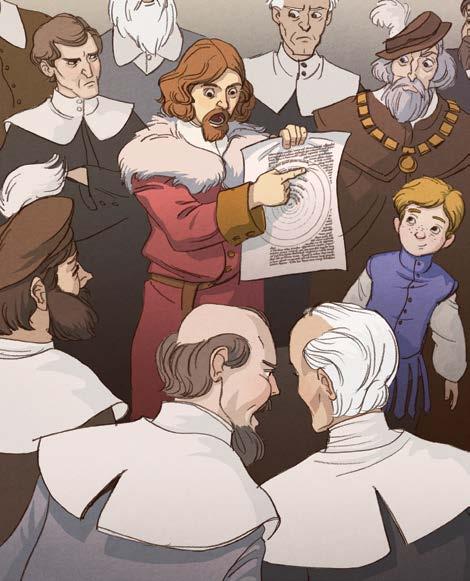
Copernicus argued that the sun, not Earth, was at the center of the universe.
Glossary for What’s in Our Universe?
A
African-American studies—the study of the history, culture, and politics of African-Americans, Americans who have ancestors from Africa Andromeda Galaxy—the spiral galaxy that is closest to the Milky Way Galaxy Apollo 11—a rocket ship that took three American astronauts to the moon in 1969 asteroid—a space rock, smaller than a planet, that orbits the sun (asteroids) asteroid belt—an area between Mars and Jupiter where thousands of asteroids orbit around the sun in a shape like a belt astronaut—a person who travels into outer space astronomer—a scientist who studies stars, planets, and outer space (astronomers) astrophysicist—a scientist who studies the physical characteristics of heavenly bodies (astrophysicists) atmosphere—an invisible, protective blanket of air around Earth and other heavenly bodies
attraction—when things are drawn to move closer together axis—an imaginary straight line through the middle of an object, around which that object spins
B
Big Bang Theory—a scientific explanation of how the universe began billion—a very large number (billions) booster rocket—one of two parts of a space shuttle that helps launch it into space by overcoming gravity (booster rockets)
C
chemical engineering—a field of study in which scientists use their knowledge of chemistry and how things in the natural world are made and interact comet—a frozen ball of dust and ice that travels through outer space (comets) constellation—stars that form a pattern or shape that looks like such things as a person, an object, or an animal as seen from Earth (constellations) courage—bravery
E
eclipse—the blocking of the light from the sun by another heavenly body (eclipses) Endeavour—a NASA space shuttle especially—very much, particularly exploration—the study of unknown places or things
G
galaxy—a very large cluster of billions of stars, dust, and gas held together by gravity and separated from other star systems by a large amount of space (galaxies) gas giant—one of the large outer planets, Jupiter, Saturn, Uranus, and Neptune, that is composed of mainly hydrogen gas (gas giants) gravity—a force that pulls things toward one another
H
Halley’s Comet—a famous comet named for British scientist Edmund Halley that is visible from Earth with the naked eye every 76 years health care—the prevention or treatment of illnesses by trained medical specialists
Hubble Telescope—a large telescope that collects information in space; It was carried into space in 1990 and will be there until 2014� hydrogen—the most common gas in the universe, which is lighter than air and easily catches fire
I
imagine—to pretend international—involving more than one country
L
ladle—a spoon or dipper with a long handle and a cup-like end used for serving liquids launch—to send a rocket into outer space (launched)
M
manned—carrying and operated by people matter—the stuff everything in the universe is made of; anything that takes up space meteor—a piece of rock that burns very brightly when it enters Earth’s atmosphere from space, also called a shooting star (meteors) meteorite—a meteor that does not fully burn up in Earth’s atmosphere and falls to Earth
meteoroid—a space rock, smaller than an asteroid, that orbits the sun (meteoroids) Milky Way Galaxy—the galaxy that contains Earth and the solar system in which it lies
N
naked eye—your eye NASA—National Aeronautics and Space Administration; an organization in the United States that directs space travel and research
O
observatory—a place used to observe the sun, moon, stars, and outer space (observatories) orbit—the curved path something in space takes around another object in space; Planets move in an orbit around the sun� (orbiting)
P
Peace Corps—a group of American volunteers who carry out projects in other countries to help improve the lives of people living there planet—a round object in space that orbits a star (planets)
Polaris—the North Star; the brightest star at the end of the handle of the Ursa Minor/Little Dipper that stays in the same place in the night sky all year long probe—a tool used to explore something, such as outer space (probes)
R
research—the kind of equipment used to collect information through experiments reusable—when something can be used more than once rotate—to turn about an axis or a center (rotating, rotates, rotation)
S
satellite—a natural or man-made object that orbits a planet or smaller object (satellites) shuttle—to go back and forth from one place to the next (shuttled) solar system—the sun, other bodies like asteroids and meteors, and the planets that orbit the sun spacecraft—a manned or unmanned vehicle designed to travel into space for research and exploration space shuttle—a manned spacecraft used for exploration
space station—a manned satellite that is made to be in outer space for a long period of time sphere—an object shaped like a ball (spheres)
T
theory—a suggested explanation for why something happens (theories) tilted—slanted or tipped to one side
U
unmanned—not carrying people Ursa Major—the constellation named by Ptolemy that is also called Big Bear; It includes the Big Dipper Ursa Minor—the constellation made of seven stars named by Ptolemy that is also called Little Bear; It is the Little Dipper
V
volunteer—a person who willingly performs a service without getting paid
W
weightlessness—to have little or no weight
Core Knowledge Language Arts
Amplify.
Editorial Staff
Susan Lambert, Vice President, CKLA Julie Weintraub, Senior Account Manager Elizabeth Wade, PhD, Managing Curriculum Developer Patricia Erno, Managing Curriculum Developer Jamie Raade, Senior Curriculum Developer Amber McWilliams, ELL Specialist Christina Cox, Copy Editor Julia Cantuaria, Associate Marketing Manager
Project Management
Matthew Ely, Director of Operations Jennifer Skelley, Senior Producer Leslie Johnson, Associate Project Manager
Design and Graphics Staff
Todd Rawson, Design Director Julia Sverchuk, Creative Director Erin O’Donnell, Senior Designer
Contributors
Ann Andrew, Desirée Beach, Leslie Beach, Brian Black, Stephanie Cooper, Tim Chi Ly, Nicole Crook, Stephen Currie, Kira Dykema, Carol Emerson, Jennifer Flewelling, Mairin Genova, Marc Goldsmith, Christina Gonzalez Vega, Stephanie Hamilton, Brooke Hudson, Carrie Hughes, Sara Hunt, Rowena Hymer, Jason Jacobs, Leslie Johnson, Annah Kessler, Debra Levitt, Bridget Looney, Christina Martinez, Sarah McClurg, Julie McGeorge, Evelyn Norman, Chris O’Flaherty, Cesar Parra, Leighann Pennington, Heather Perry, Tim Quiroz, Maureen Richel, Jessica Richardson, Carol Ronka, Laura Seal, Cynthia Shields, John Starr, Carmela Stricklett, Alison Tepper, Karen Venditti, Carri Waloven, Michelle Warner, Rachel Wolf
Core Knowledge Language Arts
Core Knowledge Foundation
Series Editor-in-Chief
E. D. Hirsch Jr.
President
Linda Bevilacqua
Editorial Staff
Mick Anderson Robin Blackshire Laura Drummond Emma Earnst Lucinda Ewing Sara Hunt Rosie McCormick Cynthia Peng Liz Pettit Tonya Ronayne Deborah Samley Kate Stephenson Elizabeth Wafler James Walsh Sarah Zelinke Design and Graphics Staff
Kelsie Harman Liz Loewenstein Bridget Moriarty Lauren Pack
Consulting Project Management Services ScribeConcepts.com
Additional Consulting Services
Erin Kist Carolyn Pinkerton Scott Ritchie Kelina Summers
Acknowledgments These materials are the result of the work, advice, and encouragement of numerous individuals over many years. Some of those singled out here already know the depth of our gratitude; others may be surprised to find themselves thanked publicly for help they gave quietly and generously for the sake of the enterprise alone. To helpers named and unnamed we are deeply grateful. Contributors to Earlier Versions of These Materials Susan B. Albaugh, Kazuko Ashizawa, Kim Berrall, Ang Blanchette, Nancy Braier, Maggie Buchanan, Paula Coyner, Kathryn M. Cummings, Michelle De Groot, Michael Donegan, Diana Espinal, Mary E. Forbes, Michael L. Ford, Sue Fulton, Carolyn Gosse, Dorrit Green, Liza Greene, Ted Hirsch, Danielle Knecht, James K. Lee, Matt Leech, Diane Henry Leipzig, Robin Luecke, Martha G. Mack, Liana Mahoney, Isabel McLean, Steve Morrison, Juliane K. Munson, Elizabeth B. Rasmussen, Ellen Sadler, Rachael L. Shaw, Sivan B. Sherman, Diane Auger Smith, Laura Tortorelli, Khara Turnbull, Miriam E. Vidaver, Michelle L. Warner, Catherine S. Whittington, Jeannette A. Williams. We would like to extend special recognition to Program Directors Matthew Davis and Souzanne Wright, who were instrumental in the early development of this program. Schools We are truly grateful to the teachers, students, and administrators of the following schools for their willingness to fieldtest these materials and for their invaluable advice: Capitol View Elementary, Challenge Foundation Academy (IN), Community Academy Public Charter School, Lake Lure Classical Academy, Lepanto Elementary School, New Holland Core Knowledge Academy, Paramount School of Excellence, Pioneer Challenge Foundation Academy, PS 26R (the Carteret School), PS 30X (Wilton School), PS 50X (Clara Barton School), PS 96Q, PS 102X (Joseph O. Loretan), PS 104Q (the Bays Water), PS 214K (Michael Friedsam), PS 223Q (Lyndon B. Johnson School), PS 308K (Clara Cardwell), PS 333Q (Goldie Maple Academy), Sequoyah Elementary School, South Shore Charter Public School, Spartanburg Charter School, Steed Elementary School, Thomas Jefferson Classical Academy, Three Oaks Elementary, West Manor Elementary. And a special thanks to the CKLA Pilot Coordinators, Anita Henderson, Yasmin Lugo-Hernandez, and Susan Smith, whose suggestions and day-to-day support to teachers using these materials in their classrooms were critical.
Credits Every effort has been taken to trace and acknowledge copyrights. The editors tender their apologies for any accidental infringement where copyright has proved untraceable. They would be pleased to insert the appropriate acknowledgment in any subsequent edition of this publication. Trademarks and trade names are shown in this publication for illustrative purposes only and are the property of their respective owners. The references to trademarks and trade names given herein do not affect their validity. All photographs are used under license from Shutterstock, Inc. unless otherwise noted.
expert reviewer Charles Tolbert
writers Core Knowledge Staff, Fritz Knapp
illustrators and image sourCes
Title Page (Stars): Shutterstock; 3 (Sun): Shutterstock; 4 (Close-up sun): Shutterstock; 5 (Planets orbiting): Shutterstock; 6 (Earth on axis): Core Knowledge Staff; 7 (Earth and seasons): Core Knowledge Staff; 9 (Moon): Shutterstock; 10 (Moon phases): Shutterstock; 11 (Solar Eclipse): Shutterstock; 13 (Lunar Eclipse): Shutterstock; 15 (Telescope): Shutterstock; 17 (Sun and planets): Shutterstock; 19 (top-Mercury):Shutterstock, (bottom-Venus): NASA; 21 (Mars): Shutterstock; 23 (Solar System): Shutterstock; 24 (Jupiter): Shutterstock; 25 (Saturn): Shutterstock; 27 (Neptune): Shutterstock; 29 (top-Asteroid belt):NASA/JPL - Caltech, (bottom-Asteroid): NASA/ JPL- Caltech; 31 (Comet): Shutterstock; 33 (top-Meteor shower): Shutterstock, (bottom-Meteor): Shutterstock; 35 (Stars): Shutterstock; 37 (Stars): Shutterstock; 39 (Milky Way): Shutterstock; 41 (Andromeda): Shutterstock; 43 (Night sky): Shutterstock; 45 (Ursa Major): Shutterstock; 47 top (Big Dipper) bottom (Ursa Minor: Shutterstock; 49 (Pointer stars): NASA, ESA, N. Evans (Harvard- S 51 (Galileo): public domain; 52 (Observatory): Shutterstock; 53 (Hubble): NASA; 55 (top-Ham): NASA, (bottom-Shepard): NASA; 56 (Apollo 11 lift-off): NASA/NASA History Office/Kenned 57 (Apollo 11): NASA; 59 (Astronauts): NASA; 61 (Footprints on the moon): NASA; 63 (Buzz): NASA; 65 (Splashdown): NASA; 66 (High jump): Shutterstock; 67 (Astronaut in spaceship): NASA; 68 (Gravity-free): NASA; 69 (Floating lunch): NASA/Johnson Space Center; 71 (Earth from the moon): Shutterstock; 73 (Lift off): NASA; 75 (Shuttle orbit): ISS Expedition 28 Crew, NASA; 77 (Shuttle landing): NASA; 79 (Mae Jemison): NASA; 81 (Stanford): BrokenSphere / Wikimedia Commo 83 (Weightlessness): NASA; 85 (Jemison): NASA/Johnson Space Center; 87 (Space station): NASA; 88 (Astronauts jog): NASA; 89 (Two astronauts): NASA; 91 (Space shower): NASA; 93 (Edwin Hubble): Jed Henry; 95 (Big Bang Theory): Jed Henry; 97 (Universe): Jed Henry; 99 (Satellite): NASA / WMAP Science Team; 101 Young Copernicus): Jed Henry; 103 (Copernicus): Jed Henry; 105 (Copernicus): Jed Henry










